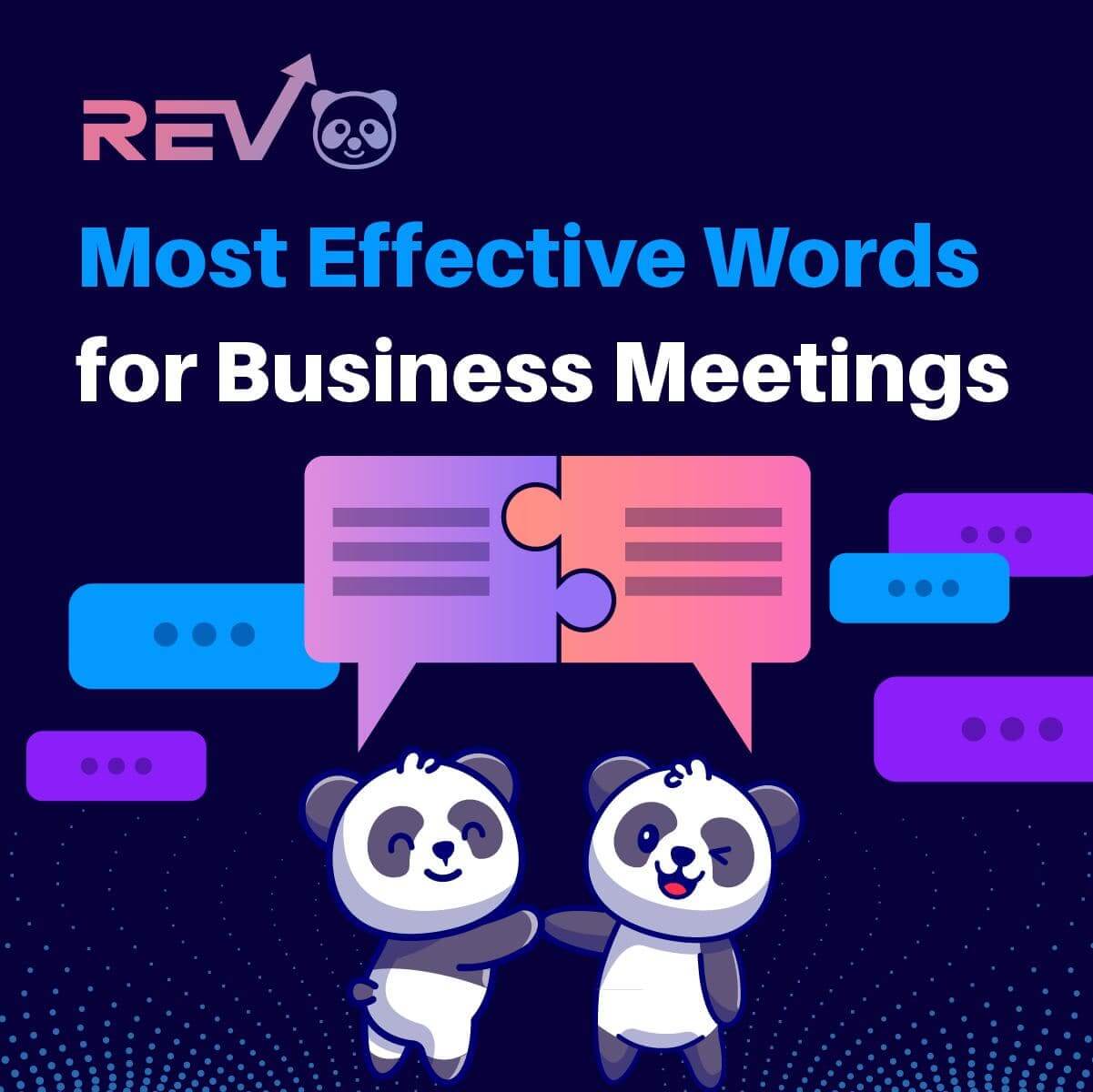
post
6 Highly Effective Words for Business Meetings

Table of contents
Click on a title to jump to a section
And apart from formal attire, firm handshakes, and killer presentations, effective communication.
Since English is the global language of choice, it’s important to increase your competence and fluency to make a positive impression where it counts. Using powerful words, phrases, and tone in the workplace can significantly boost career progression.
According to an independent study conducted by MIT Sloan School of Management Professor Cynthia Rudin and PhD student Been Kim, certain words have a greater impact when moderately used in professional communication. These are:
- Yeah – While saying yeah in a business meeting might sound unprofessional, according to research, framing a suggestion in agreement with a previous suggestion increases the chances of the latter being accepted. This works when the suggestions complement one another.
- Give – Give has three primary functions in a corporate conversation. The first is giving respect to the topic of the meeting. The second is giving attention to the participants. And the third is giving importance to previous data and resources.
- Start – The word start gives participants common ground to agree. This is useful in situations where the agreement of basic suggestions indicates that the team wants to work together. This type of conversation is crucial for initial team-building meetings.
- Meeting – This generally appears in suggestions of what not to discuss. For instance, suggesting the topic for the next meeting is a subtle way of reminding the participants that they’re deviating from the original topic.
- Discuss – Even though most people find it negative, the word discuss plays a crucial role in business meetings. In fact, it primarily appears in an organisational context. Here is an example.“I don’t think we should discuss such elaborate subjects”. Research shows people tend to readily agree with organisational suggestions.
- Find – Often used to gather additional information or coax employees into taking up the additional task, the word is best used suggestively. For example, “We must find out if that’s possible”. Furthermore, it encourages people to take action towards the goals.
When you use these words at the beginning of a meeting, they grab and retain attention. But when used at the end of a meeting, they prompt a positive reply. The study also found that unstructured meetings are detrimental to the purpose of a group discussion and are more likely to cause headaches.

Your most important task while addressing a meeting is to acquaint the audience and set the mood for the presentation. Breaking the ice is the crucial first step and it’s much easier than you think.
Helpful Ice Breakers for Business Meetings
Ice breakers are excellent for helping strangers warm up. They’re equally helpful when introducing an unfamiliar topic for discussion. There are three primary objectives for ice breakers, which are:
- Helping strangers get familiar with the environment
- Setting the tone for the meeting
- Helping speakers connect with the audience
The first step when breaking the ice is identifying the goals. Once you’ve identified the goals, finding the right ice breaker for business meetings isn’t a major hassle. Countless variations can be used to a similar effect. Let’s take a look at a few popular examples and learn how to use them.
- Introductory Ice Breakers – This is an excellent way of introducing participants and promoting a healthy conversation. Cracking business jokes or asking people to share their name, service duration, role, and a little-known fact humanises the interaction.
- Team-Building Ice Breakers – An excellent effort to promote camaraderie among newly inducted team members. The Human Web and the Ball Game are two powerful ice breakers that can be leveraged during the initial interaction.
- Topic Exploration Ice Breakers – These are ideal for exploring new topics during a meeting, re-energising the participants, or changing the pace. Brainstorming sessions can work wonders, provided the subject is intriguing and fun.
When and How to Use Powerful Words in a Business Meeting?
The trick to using key meeting words successfully is to uniformly sprinkle them in a conversation. However, for optimum impact, use the following communication tactics.
- The Opening Statement – Using the four power words to open a meeting helps grab attention from the beginning. For instance, using the word yeah demonstrates acceptance and your commitment to the meeting. Using the word start immediately grabs the audience’s attention and they know the time for casual chit chat is over. Similarly, throwing the word give into a sentence draws the attention of the speaker as you trigger a subconscious reaction about being rewarded something valuable. Finally, the word meeting sets the tone of the event, informing participants that the subsequent discussion will be formal.
- Changing the Topic – When changing the subject, it’s often difficult to convince every participant to change gears at the same time. The word yeah can help with transitioning as agreeing with what is being said grabs attention. You can then use the limelight to change the topic. The word start is equally effective as it informs the audience about the impending change. Discussions often tend to veer from the subject at hand. By using the word meeting, you can redirect the course of the conversation. For instance, a statement like “perhaps this is a subject for our next meeting” offers a gentle reality check and is well-received by all.
- The Closing Statement – Using the right words at the end of a business meeting can help garner a warm response and increase acceptance of your proposals. Research shows there is an element of neurolinguistic programming at play among the listeners when the speaker uses positive words like yeah, start, and give in the ending note. Phrasing your proposals as if they’re automatically accepted helps incite a reciprocal response. And while it might not be 100% successful every time, using these four words at the right moment improves the success rate. But why do these words hold so much sway?
Why Are Meeting Words Highly Effective?
There are several reasons why these five words are critical during business meetings. Let’s analyse the two major factors.
- Compliments Don’t Always Have the Intended Results – According to MIT research, compliments given at a meeting don’t always overshadow negative comments and are often viewed as an insincere attempt to divert attention from the awkward situation.
- Decision-Signaling Words Are Crucial for Retaining Focus – The researchers found that certain words signal an imminent reaction from the audience and lend insight into the decision-making process. For example, employees expect closure when they’ve been a part of a discussion, which promotes communication.
Powerful words aren’t just reserved for physical or virtual meetings and can work wonders when sporadically used in business texts too. Revpanda specialises in creating engaging business texts for professional communication. Reach out to our experts for a free consultation and demo today!


